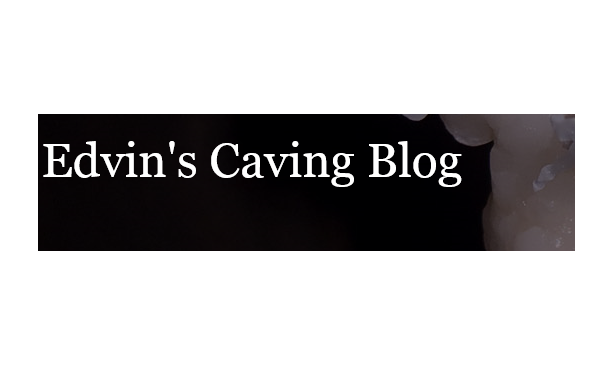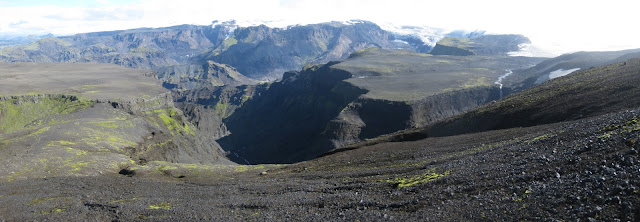| A first view of the Brenta Dolomites and Cima Tosa. |
“We didn’t realise it would be like this,” said one of the Brits, before continuing up the staples, completely unperturbed.
| Climbing the Vedretta. |
Three hours later, a series of ladders led us down to a lunch spot near a tiny 10m wide pass, separating two of the great limestone pillars. A bit of scrambling over rubble, and another snow slope in the Bocca dei Armi led us to the start of the next long section of the Via delle Bochette. This was similar in character to the morning: height gain via a series of ladders; a long traverse on ledges; then dropping down via a series of scrambles, ladders and wires.
Unfortunately, the minute we stepped onto the first set of ladders, the mist turned to rain. I rapidly discovered that via ferratas in the rain are quite slippery, with my boots providing next to no traction on the metalwork or the limestone slabs. On more than one occasion my feet vanished from under me and I slithered down the slabs until my cowstails caught me.
| Via ferrata in the rain. |
The ledges proved especially damp. Water run-off from the non-vegetated dolomitic pillars above us was near instant. And the only place for the sheets of water to go was straight onto the ledges, and directly in our path. Thank god we’d thought to pack our stuff into drybags!
Finally, 10 hours after setting off from Rifugio Tuckett (and 10 minutes before the rain stopped) we caught our first glimpse of Rifugio Tosa, only a few minutes away. It is little exaggeration to say that we arrived no drier than if we had swum there. On seeing Stuart, the hut warden said, “you might like to know that we have a drying room downstairs.” Never has a throwaway phrase been so welcome (although “here is your hot chocolate”, “here is your beer” and “here is your beer again” were also pretty good).
Day three greeted us with clear skies. The true majesty of the Dolomites was revealed: huge views of wooded valleys kilometres below, and limestone pillars soaring above into eddying clouds. But as we walked along the Sentiero Brentari, above a rubble moonscape, something was preying heavily on my mind…
| The view from partway up Cima Tosa. |
I seem to have the same love-hate relationship with climbing as I do with via ferratas and caving. Stuart had expressed an interest in a 2 hour detour to the summit of Cima Tosa, involving a couple of short pitches. And it was almost inevitable that I was going to force myself to join him.
In truth the rock climbing was probably no harder than Diff in standard. But when there is that much space around, it messes badly with my head. So as Stuart began shinning up the climb, I hurriedly passed him our paltry Decathlon 8mm ‘walking rope’ so I could at least pretend to be protected.
| Looking down the gully on Cima Tosa. |
For several metres above the climb, things appeared to be just has difficult and exposed, but eventually we found ourselves scrambling more easily up a huge rocky bowl, following a line of cairns. An hour later we were stood at the 3173m snowy summit of Cima Tosa. A gully to one side afforded a view of Rifugio al Brentei, a kilometre below. To the north, the Marmolada range was visible.
Returning towards where Kathryn and Adrian were waiting, we slowly grew accustomed to the terrain and exposure, and made rapid progress down to the top of the pitches. We encountered an Italian guide with clients at this point. Once Stuart belayed me down, the guide apparently commented on our rope, and the two of them converged towards conversing in German, being the only common language. Nonetheless, it was never clear whether the guide was impressed by our lightweight approach to the climb, or thought we were utter numpties!
The next stretch of via ferrata led along another series of mid-cliff ledges to a suite of ladders down onto the icy Vedretta d’Ambies. After slithering past a couple of small crevasses, a fair chunk of height was lost, only to be gained again with a sweaty walk above the Rifugio Agostini.
| Ladder climbing in the cloud. |
With clouds billowing in once more, we began our final via ferrata of the day: 13 ladders leading almost straight up 200m to a tiny brèche. From here we were afforded a fine view through thin clouds to the Rifugio Dodici Apostoli, our stop for the night, far below. Rain began to set in as we raced across snow slopes and screes and down the bouldery valley, but we arrived somewhat drier than the previous day.
After another fitful night’s sleep, during which it became clear that the toilet smelt considerably nicer than our 4 unwashed-person dorm, we set off on our final day above a fine temperature inversion. 300m of climbing up moraine led to the Vedretta dei Camosci. The ice was as hard as rock and very steep so crampons were needed here. Now a mere 1200m of descent lay between us and the car at Vallesinella: down the great hanging valley holding the glacier, round the base of Cima Tosa to Rifugio al Brentei, and past Rifugio Casinei, where a celebratory rifugio lunch was taken.
| Vedretta dei Camosci. |
A minor hiccup was encountered back at the car, where a parking ticket was found on the windscreen. Tragically however, the date had washed off, and none of us could remember when we had arrived. But it was certainly within the last 24 hours anyway…
I can’t recommend via ferrata in the Brenta Dolomites highly enough. Distinctive, out-of-this-world landscapes, fun ferratas and fine rifugios. What a trip!



























